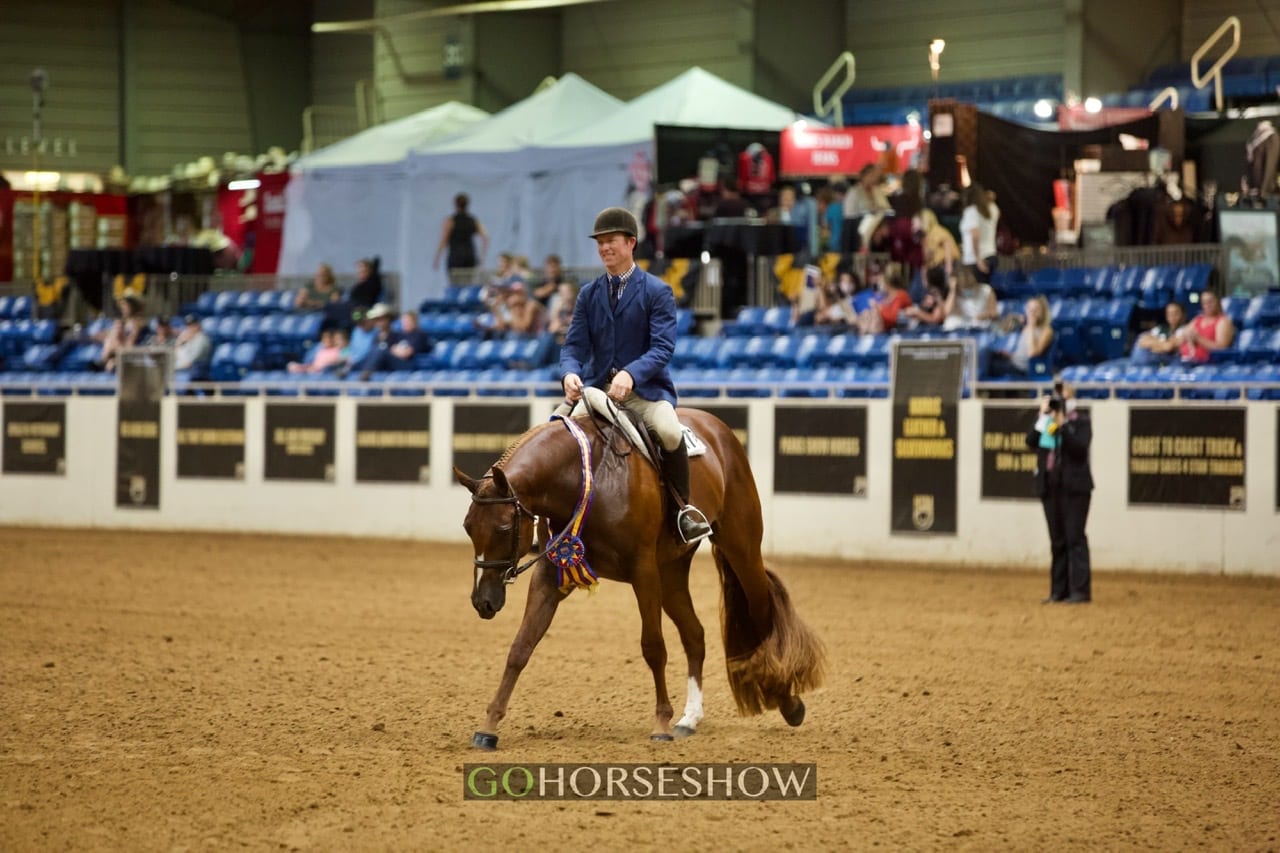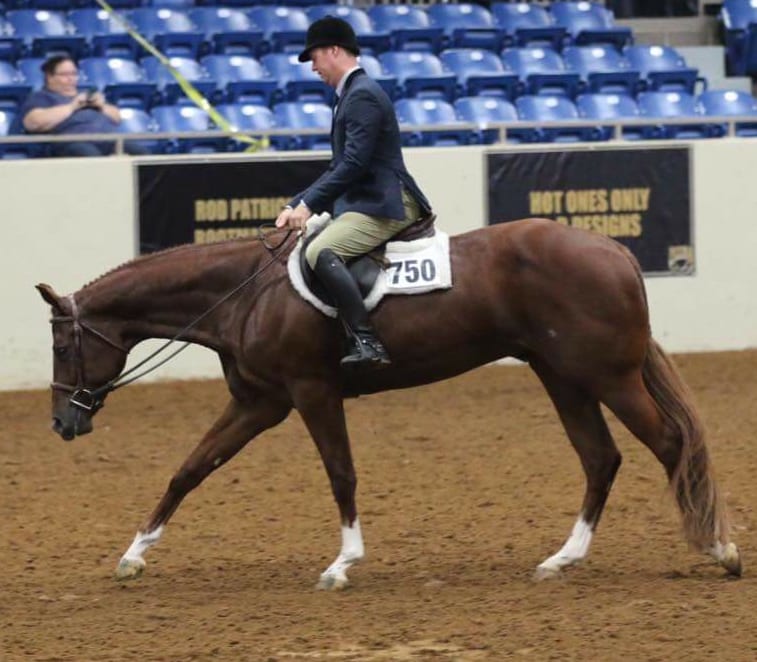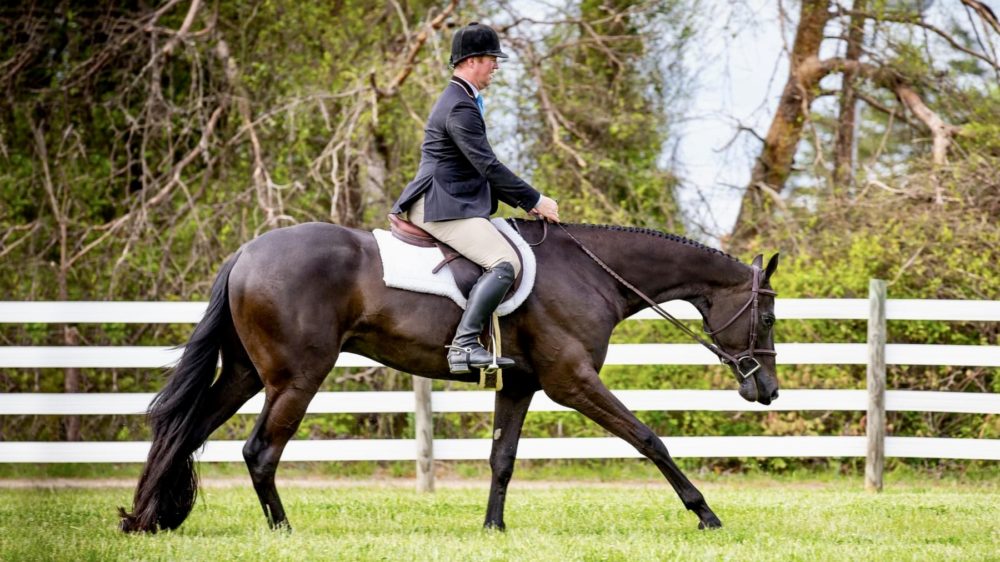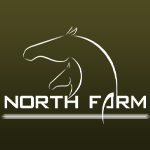It is a common misconception that when judges and trainers ask for a longer stride in the Hunter Under Saddle classes, that this request automatically means they want more speed. Indeed, it is entirely possible to lengthen a horse’s stride without increasing their speed.
We spoke with multiple World and Congress Champion Hunter Under Saddle trainer Keith Miller to get his tips for lengthening the stride on your Hunter Under Saddle horse without speeding up their legs.
Before delving into specific tips, Miller indicated that it is helpful to visualize what he is talking about by considering the following analogy: If Shaquille O’Neal is walking at a steady, normal pace, a 5ft tall individual will likely need to walk very quickly beside him to stay apace of him.
In this example, both individuals are moving at the same speed, but one will have quick legs while the other has slower legs and greater reach. The goal for hunt seaters is to develop the Shaquille O’Neal cadenced, comfortable, reaching stride and not a short, fast, quick-legged stride.
Do Your Research
Knowing the goal of the stride in a hunt seat class is the first step to understanding the process for achieving it.
“The ultimate goal is for the movement to be collected, cadenced, lofty, and long. In order to accomplish this correctly, the horse needs to move forward, while lifting their energy upward through their shoulder while they hold the ground,” Miller explains.
He goes on, “You want the mental illusion that your horse’s feet are sticking to the ground a beat and then lifting up such that they are momentarily airborne while the shoulder really reaches forward to allow those front feet the freedom of a large stride.”
Miller laments, “It can be really hard for amateurs to understand the concept of being big-strided and slow-legged all at once. Therefore, I recommend my amateurs watch the open classes and see what it looks like when the professionals do it.”
 Keith emphasizes, “The top professionals aren’t running the horses’ legs off, doing donuts around the center of the arena. In fact, their horses’ legs aren’t moving that quickly at all, but the shoulders are free and the legs are swinging in a cadenced, slow, lofty manner.”
Keith emphasizes, “The top professionals aren’t running the horses’ legs off, doing donuts around the center of the arena. In fact, their horses’ legs aren’t moving that quickly at all, but the shoulders are free and the legs are swinging in a cadenced, slow, lofty manner.”
Miller also advises that riders watch dressage exercises and how-to videos. He clarifies, “While the discipline itself is different, the building blocks are actually quite similar. The goal is to get a responsive horse who can use the various parts of their body both independently and as a unit to perform complicated, controlled maneuvers. Listening to what they do and why they do what they do can have real applications for the hunt seat classes.”
Understand What Correctness Feels Like
Perhaps the most difficult aspect of understanding how to lengthen stride without racing around the arena boils down to “feel.” Miller acknowledges that this topic can be difficult to provide advice for because the rider simply has to feel the extension.
“When I’m unable to communicate a concept with my riders, I always go back to video,” Miller explains. “I like to take lots of video of their rides so that I can connect the visual with the feeling in the moment. When the trot is hollow, flat, and quick, I want them to see video of what that feeling translates to on the rail. When the stride is collected, cadenced, and long, I want them to see that so they can feel the difference and make the proper adjustments in the saddle.”
“Whether it’s good or bad, videos don’t lie. If you are able to see what you’re doing and what your horse is doing, it gives a full picture to what you are feeling and better allows you to take direction from your trainer and communicate with your horse.”
Give Your Horse a Proper Warm Up
Now that you know what a correct stride looks like and is supposed to feel like, you can actually go to work.
In order to ensure his horse’s shoulders are free and they are ready to perform their “show trot,” Miller emphasizes a strong warm up. “You don’t see a ballerina just put on their shoes and perform the most difficult move in their repertoire. No. Stretching and warm up are critical to their ability to give their best performance,” he laughs.
 Keith finds that the best stretches for his horses are those that get their body parts moving independently of one another. He will begin his rides at a purposeful walk, breaking up their shoulders and their hips by side passing and moving their shoulders over and then moving their hip the opposite way to get them limber and responsive.
Keith finds that the best stretches for his horses are those that get their body parts moving independently of one another. He will begin his rides at a purposeful walk, breaking up their shoulders and their hips by side passing and moving their shoulders over and then moving their hip the opposite way to get them limber and responsive.
Miller then moves into a working/extended jog and does the same thing. “I like to work my horses at a nice sitting trot so that I can push them into the bridle with my seat and legs and actually feel them rocking back onto their hind end and lifting their shoulders up. You should really feel like it is a springy, lofty, but comfortable gait.”
Keith says, “The only way for a hunt seat horse to physically lengthen their stride is for them to drive forward from behind while opening their shoulder so that their front end doesn’t collapse and stop the hind legs from driving. Therefore, exercises and warm ups should focus on lifting the shoulders and moving them around while really driving from behind.”
Miller emphasizes that you don’t want to chase your horse with your seat, such that they are encouraged to move quickly instead of lengthening. “You want to kick hard to get the drive and post slow to avoid the chase.”
He also finds that most horses seem to trot better after they canter. So, he will loosen them up at the walk, then at the sitting extended jog, and then he will canter. Once he’s gotten correct lift and reach from those movements, he will ask for the “show trot” at the end, when their bodies are in a position to do what is asked of them.
Showcase the Horse You Have
Finally, just how far a horse can lengthen their stride is often more a matter of conformation than anything else. If the horse’s shoulder doesn’t stand up properly to allow for the desirable swinging motion, no amount of stretching or training can change that.
 Miller reminds us, “At the end of the day, you need to show the horse you have and not the horse you want to have. Not every horse is over 17h such that their stride is naturally longer and not every 17h+ horse has the proper shoulder structure to reach to their full stride potential.”
Miller reminds us, “At the end of the day, you need to show the horse you have and not the horse you want to have. Not every horse is over 17h such that their stride is naturally longer and not every 17h+ horse has the proper shoulder structure to reach to their full stride potential.”
“The goals is to showcase correct movement – or, at least, as close to the standard as possible for your individual animal,” Miller emphasizes. “If your horse has a weak trot, find ways to make it look the best it can, but don’t try to keep up with the bigger-strided animals because you will end up looking like you’re running around.”
Alternatively, he says, “If you have a big-strided animal, don’t run circles around everyone. Horses with huge strides require a lot more finesse in piloting them around the arena to avoid traffic jams and getting stuck on the inside.”
Ultimately, “Every horse has their strengths and weaknesses and it’s important to work with your trainer to understand what you and your horse are brining to the table so you can play on your strengths and minimize your struggles.”
***
In closing, Miller reminds us that, “More speed isn’t better. You want to cover ground, but simply because you’re trotting fast doesn’t mean you’re trotting correctly. You want to aim to move strong and slow with reach, which requires stay. If you can fit all those elements together, you’re well on your way to out-performing many individuals in the class.”








